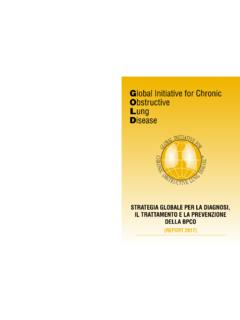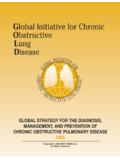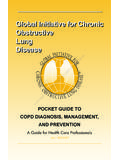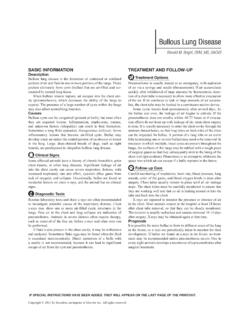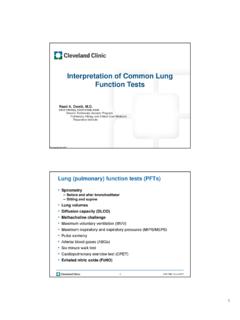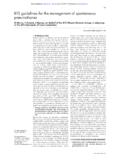Transcription of TUBERCULOSIS INFECTION CONTROL - WHO
1 TUBERCULOSIS INFECTION CONTROL IN THE ERA OF EXPANDING HIV CARE AND TREATMENT Addendum to WHO Guidelines for the Prevention of TUBERCULOSIS in Health Care Facilities in Resource-Limited Settings, 1999 Writing committee: Centers for Disease CONTROL and Prevention (CDC): Naomi Bock, Paul Jensen, Wanda Walton, Michael Iademarco, Bess Miller World Health Organization (WHO): Alasdair Reid, Pierre-Yves Norval, Paul Nunn International Union Against TUBERCULOSIS and Lung Disease (The Union): Riitta Dlodlo Acknowledgements Mary Catlin, William Coggin, Elizabeth L. Corbett, Reuben Granich, Chris W. Green, Eric Ikoona, Pecharin Kaewrakmook, Saiyud Moolphate, Mary Nandili, Supalert Nedsuwan, Lisa Nelson, Jintana Ngamvithayapong-Yanai, Joseph Odhiambo, Naraworn Puraksa, Caroline Ryan, Supaporn Trongsakul, Jeroen van Gorkom and Charles Wells reviewed these guidelines and provided useful comments. Materials developed by the Francis J Curry National TUBERCULOSIS Center Institutional Consultation Services provided helpful templates.
2 CONTENTS Preface Why this addendum was developed Who should use this addendum Note on the use of TB and Mycobacterium TUBERCULOSIS Introduction Why TB is a problem in HIV care settings How Mycobacterium TUBERCULOSIS is spread The difference between TB INFECTION and TB disease When TB is infectious How HIV care settings can reduce the risk of spreading TB Work practice and administrative CONTROL measures Overview INFECTION CONTROL plan Administrative support Training of staff Education of patients and community awareness Coordination and communication with the national and local TB program Personal respiratory protection Environmental CONTROL measures Protection of health care workers Increasing awareness of TB in health care workers and staff Increasing access to HIV voluntary counseling and testing Multi-drug resistant TB Drug rehabilitation centers/correctional institutions Operational research priorities References Other Resources Glossary Annexes Sample INFECTION CONTROL plan Sample monitoring tools 2 Training material for staff Education materials for patients B.
3 Information on Ventilation and Fans C. Inpatient settings D. Multi-drug resistance Frequently Asked Questions 3 PREFACE WHY THIS ADDENDUM WAS DEVELOPED The goal of this addendum is to help management and staff minimize the risk of TB transmission at facilities in resource-limited settings in which: HIV-infected persons receive diagnosis, care, treatment, and/or support, such as voluntary counseling and testing centers, clinics for HIV care including primary health care clinics, antiretroviral therapy (ART) clinics, and support clubs for people living with HIV/AIDS; and There is a high prevalence of HIV INFECTION , both known and undiagnosed, in settings such as prisons, jails, other detention centers, and drug rehabilitation centers. In this era of increasing access to HIV counseling and testing, care, and treatment for people living with HIV, more people living with HIV-associated immunosuppression are attending health care and community facilities than ever before.
4 Persons, including health care workers, with HIV-associated immunosuppression are particularly vulnerable to developing TB disease if they become infected with Mycobacterium TUBERCULOSIS (M. TUBERCULOSIS , the germ that can cause TB) as a result of exposure in these settings. The Guidelines for the Prevention of TUBERCULOSIS in Health Care Facilities in Resource-Limited Settings1 published by the World Health Organization in 1999 addresses issues related to inpatient facilities. This document supplements rather than replicates that guidance and addresses inpatient facilities only in Annex C. It aims to give the reader a greater understanding of the following issues in the context of HIV care settings: TB transmission in facilities providing services to people living with HIV INFECTION and disease; INFECTION CONTROL procedures to reduce the risk of M. TUBERCULOSIS transmission in HIV/AIDS care facilities; Protection of health care workers and staff through HIV voluntary counseling and testing (VCT), increasing awareness of TB in staff and preventive action; Importance of TB INFECTION CONTROL in drug rehabilitation centers; correctional institutions including prisons, jails, other detention centers; and other facilities where large numbers of HIV infected individuals gather; Issues of multi-drug resistant TB (MDRTB).
5 WHO SHOULD USE THIS ADDENDUM This document is for policy makers, health care workers, administrators, and stake holders in the public, private, and nongovernmental health sector involved in providing care and treatment to persons with HIV/AIDS. It can also be helpful 4 for persons or institutions responsible for the health and well-being of large numbers of persons living with HIV/AIDS (PLWHA). Settings include VCT centers, community-based outreach centers, ARV and other HIV care clinics, hospices, general health care facilities, drug rehabilitation centers, and correctional institutions including prisons and jails. NOTE ON THE USE OF TB , M. TUBERCULOSIS AND TB SUSPECT The words TUBERCULOSIS (TB) and M. TUBERCULOSIS , the bacterium that causes TB, are used in different ways. This document uses TB to describe clinical events, such as TB INFECTION , TB transmission, and TB disease; M. TUBERCULOSIS is used when describing potentially infectious germs that a person with TB disease of the lungs or larynx expels when coughing.
6 TB suspect refers to a person who presents with symptoms or signs suggestive of TB disease, in particular a cough of long duration. INTRODUCTION WHY IS TB A PROBLEM IN HIV CARE SETTINGS? Persons with undiagnosed, untreated and potentially contagious TB are often seen in HIV care settings. TB is the most common opportunistic INFECTION and a leading cause of death in persons living with HIV/AIDS (PLWHA). In high TB burden settings, surveys have shown that up to 10% of persons with HIV INFECTION may have previously undiagnosed TB at the time of HIV voluntary counseling and testing (VCT), including at centers providing prevention-of-mother- to-child HIV transmission (PMTCT) services. 2,3,4 Up to half of these may be infectious TB cases. Between 30% and 40% of PLWHA living in high burden TB settings will develop TB in their lifetime, in the absence of isoniazid preventive therapy or antiretroviral The risk of developing TB disease doubles in the first year after becoming HIV-infected and gets progressively higher over time.
7 6 Persons without TB disease at the time of HIV diagnosis may still develop TB in later years, and will then be at risk of spreading M. TUBERCULOSIS in the community as well as to fellow patients, healthcare workers, and staff at their HIV care clinics and in community programs. Persons with HIV-associated immunosuppression may become infected or re-infected with TB if they are exposed to someone with infectious TB disease. They can progress rapidly from TB INFECTION to disease over a period of months rather than a period of years as is common for persons with a normal immune system. 5 Health care workers and other staff are also at particularly high risk of INFECTION with TB because of frequent exposure to patients with infectious TB disease. Health care workers and staff may themselves be immunosuppressed due to HIV INFECTION and be at higher risk of developing TB disease once infected. Multiple TB outbreaks affecting HIV-infected patients and health care workers due to health care facility exposures were documented in industrialized countries in the 1990s.
8 7 These coincided with the early period of the HIV epidemic, before TB INFECTION CONTROL procedures in health care facilities were strengthened. This document provides information on measures that can be taken, even in resource-limited settings, to prevent unnecessary morbidity and mortality due to TB transmission in health care settings. Work practice, administrative CONTROL measures and environmental CONTROL measures are the focus of this addendum. Other issues addressed are HIV and TB in health care workers and staff, and protecting their health; MDRTB; and specialized facilities such as drug rehabilitation centers. HOW IS TB SPREAD? TB is caused by M TUBERCULOSIS . People who have TB disease in their lungs can release tiny particles containing M. TUBERCULOSIS into the air by coughing. These particles are called droplet nuclei. They are invisible to the naked eye. Droplet nuclei can remain airborne in room air for many hours, until they are removed by natural or mechanical ventilation.
9 To spread, there must be a source, a person with TB disease who produces M. TUBERCULOSIS , and an exposed person to inhale droplet nuclei containing the bacteria. Although TB is not usually spread by brief contact, anyone who shares air with a person with TB disease of the lungs in an infectious stage is at risk. A person who inhales one or more of the droplet nuclei can become infected with M. TUBERCULOSIS . HOW IS TB DISEASE IN THE LUNGS DIAGNOSED The most common part of the body to have TB disease is the lungs. In resource-limited settings TB disease in the lungs is diagnosed by examining samples of sputum with a microscope. The sputum is smeared onto a small glass plate, stained with chemicals, and viewed under the microscope. If M. TUBERCULOSIS bacilli are present, they can often (but not always) be seen. These diagnostic tests are referred to as sputum smears . Sometimes chest radiography is done to assist with making the diagnosis.
10 6 VACCINATION WITH BCG The Bacille Calmette-Gu rin (BCG) vaccine is a live vaccine derived from a strain of Mycobacterium bovis (similar to M. TUBERCULOSIS ) first administered to humans in 1921. Since that time, many different strains have been derived and are used today throughout the world to prevent TB disease. BCG vaccination reduces the risk for progression from latent TB INFECTION to TB disease, especially disseminated or central nervous system disease in children. BCG vaccination may cause a positive reaction to a tuberculin skin test. THE DIFFERENCE BETWEEN TB INFECTION AND TB DISEASE TB INFECTION TB INFECTION is the state of having a small number of M. TUBERCULOSIS bacteria in the body which are unable to grow due to CONTROL by the immune system. The bacteria are inactive, but remain alive in the body and can become active later. This condition is also referred to as latent TB INFECTION (LTBI). TB INFECTION does not cause a person to feel sick, and there are no symptoms, nor are there signs detected upon medical evaluation.










